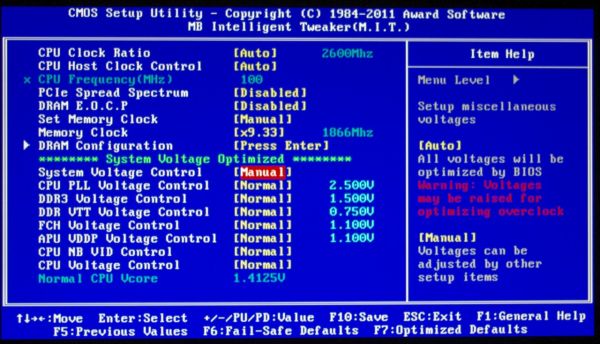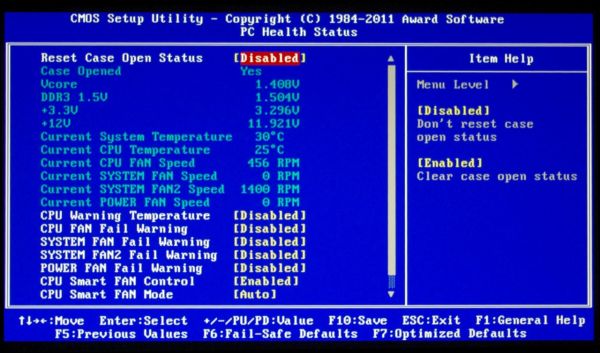ASUS F1A75-V Pro vs. Gigabyte GA-A75-UD4H – Llano at ~$120
by Ian Cutress on November 7, 2011 6:00 AM EST- Posted in
- Motherboards
- Gigabyte
- Asus
- A75
BIOS
Gigabyte is still adhering to the old-fashioned BIOS look. We will not get any graphical interface until X79, as Anand showed us previously. This is positive and negative—positive in the sense that it should be very stable, easy to use and users should recognize the standard layout; however this should mean it is perfect, or users would prefer something more easily readable.
First of all, I had a love-hate relationship with the BIOS. Getting into it was tricky—normally I hold down DEL during post. When I did that with this board, the cursor would just blink at me and nothing would happen—this occurred both with the F4 and F6 BIOSes. A response from Gigabyte indicates this is known issue on some USB keyboards being mounted late in the POST sequence.
The BIOS itself is recognizable from the moment you go into it. Overclock options are at the top, followed by the others. Inside the OC options are simple to understand, but there are no auto-OC options in the BIOS for users. Though in terms of the memory, Gigabyte utilizes a system to implement XMP profiles, or preset values of memory speed. However, on selecting non-XMP high memory frequencies, the board would have serious issues.
On my Patriot kit, on selecting 1600 MHz memory, the board would auto the subtimings to 6-11-11, which are very unbalanced. 1866 MHz would not boot, unless I manually put the timings to something like 11-11-11. Using my G.Skill kit, 1333 MHz defaults to 8-8-8, 1600 MHz defaults to 9-9-9, but 1866 MHz would not boot unless I set the timings (when 9-9-9 worked). This means that perhaps the auto settings in the memory are either tight, or not properly configured for optimal compatibility. This was even with the F6 BIOS, which states to improve compatibility.
Despite all this, there is an E.O.C.P option, which applies a memory overclock while attempting to keep the CPU at a similar speed through multiplier reductions and frequency changes. These options actually work well, as noted in the OC section below.
CPU OC is straightforward—up the Frequency when you cannot play with the multiplier, and adjust the voltage. The voltage adjust is in terms of an offset rather than a value, but the expected value is also given beside your offset.
In terms of BIOS fan options, we are quite limited. The CPU fan can be adjusted to be dependant on CPU voltage, or the state of the PWMs. There is no movement for temperature here, or much control over the system fan headers—either Smart FAN Control is enabled or disabled. There are slightly more options in the OS Software, but not many.
There is no simple one-click boot override in the BIOS, and no information about the system provided on the front page. Both of these are given by ASUS and other vendors who have adopted a graphical interface.
Overclocking
Overclocking on the GA-A75-UD4H was a mixed bag. I’m a big fan of automatic OC options on boards (even on non-performance oriented products), but Gigabyte have not provided any for the CPU—all users must do this manually by adjusting the CPU Multiplier (if a Black Edition processor is being used) or the CPU frequency. There are some automatic memory overclock options, however.
CPU
Given previous successful overclocks with this processor, I jumped in straight at 26x130 MHz (+30%) overclock on automatic settings. This booted fine into Windows.
In order to get 26x140 MHz working, I had to provide a +0.1 V offset to the CPU, resulting in 1.5125V going through the power plane. At this level of voltage offset, both 143 MHz and 145 MHz gave various stability issues, leaving a 26x140 MHz = 3.64 GHz (+40%) overclock, which is perfectly respectable.
Memory
One thing I like about this board is the memory OC options. The BIOS gives two modes of memory overclock—through DRAM E.O.C.P. or Memory Clock. The Memory Clock option allows the user to select the multiplier for the memory. I found this option fairly flaky at 1866 MHz on my two sets of memory. However, DRAM EOCP works a charm.
It offers using the XMP profile on my memory, then gives options from 1866 MHz to 2400 MHz on the memory, supplying voltage and sub-timings as required. At the 2400 setting, the CPU multiplier, CPU frequency, and Memory strap were adjusted to achieve 2388 MHz, without pushing the CPU much further (2.688 GHz). On booting into windows, it applied 9-11-9 sub-timings on the memory.
I was able to push the memory further to 2500 MHz @ 9-11-9 without too much difficulty. Note the memory I was using is rated for 2133 MHz @ 9-11-9, 1.65 V, suggesting good application by the board.
Combined
In terms of a combined CPU/Memory overclock, I put the memory at the EOCP 2400 MHz setting, adjusted the CPU multiplier to 26x128 MHz (3.328 GHz) which required a +0.1 V CPU voltage offset, giving a good overall overclock on this board.


















47 Comments
View All Comments
androk - Monday, November 7, 2011 - link
They should really test the IGP at reasonable graphics levels compared to what it can do. AVideo test at 1920x1080 and all grahpics options on is silly fo rhtis. There may have been real differences at medium (playable) settings but we'd never know it from this write up.Shadowmaster625 - Monday, November 7, 2011 - link
$120 for just a motherboard? Really? Can i get a WTF? I just bought a G41 mobo, an E6600, and a HD 4850 all for a combined cost of under $100. It overclocks to 3.2GHz, which is enough to put it well past an A8-3850 in gaming. Well past... Actually with such a powerful gpu you really dont even need an overclock to beat a llano at gaming.Granted these were used parts, but still you can buy a brand new H61 board for $40 http://slickdeals.net/forums/showthread.php?t=3444... Combine that with a 5670 which can easily be found for under $50 and you have a $90 solution that is way faster. As if AMD needed any help killing itself... these motherboard prices are absolutely absurd.
silverblue - Monday, November 7, 2011 - link
Desktop Llano makes the most sense in HTPCs. As people are willing to pay a premium for such items, I doubt AMD is too worried. Regardless, a Llano setup will use less power, you have far more multiprocessing power, and there's better video support as well as DX11 support. Llano can also be overclocked, albeit in a limited fashion, should you choose to do so. In the end, horses for courses.Laptop Llano is a more appealing option however.
Taft12 - Monday, November 7, 2011 - link
Please stop comparing prices of new and used hardware. Apples and oranges.These $120 motherboards are top-of-the-line for the FM1 socket and have the most features of any FM1 boards on the market. If cost savings is important to you, FM1 motherboards can be had for $60 or less.
Motherboard prices are NOT set by AMD, they are set by Asus and Gigabyte based on the value-add over and above what AMD provides in the chipset.
The H61 board is not $40, it's $60 with a mail-in rebate. There's a big difference.
I think this covers all the errors and misconceptions in your post... Does anyone see any that I missed...?
medi01 - Tuesday, November 8, 2011 - link
He has a point though.Motherboard prices DID go up. To an extent that you wonder if there is a cartel agreement between manufacturers.
Hard to blame AMD for it though.
swaaye - Tuesday, November 15, 2011 - link
Mobo prices haven't gone anywhere. There are consumer mobos from $80-350. Pick your poison. Pricing has been like this since 486s as far as I recall.TrackSmart - Monday, November 7, 2011 - link
Ian, just a note that the color shown for each board changes in some of the graphs. This is confusing and has me wondering if the graphs are miscolored or mislabeled...Thanks for the review.
HW_mee - Monday, November 7, 2011 - link
Does the onboard audio not deserve a mentioning?I would love to know how the ACL892 fares against the ACL889.
I know integrated audio is mediocre at best, but some past AMD boards, especially from ASUS, have featured useless cheap VIA/Realtek audio solutions.
kenyee - Monday, November 7, 2011 - link
Could you repeat this w/ their mATX boards?Googer - Wednesday, November 9, 2011 - link
The ASUS F1A75-V EVO is identical to the ASUS F1A75-V Pro, except the EVO adds an additional PCI-e x16 slot. If you watch prices close enough, you can pick this board up around $125. I got mine for $126 +$10 rebate a few weeks ago, final cost $116.The Major selling points for me on this board over the Gigabyte and competing models were, that all the other boards support 32GB while ASUS supports 64GB and the extra x16 slot seals the deal for the ASUS F1A75-V EVO.
Also, the review states how many power phases are on the Gigabyte board (8+2) but didn't specify how many phases are on the ASUS.